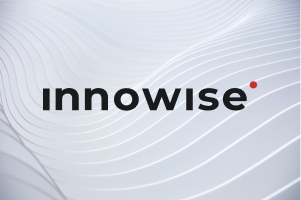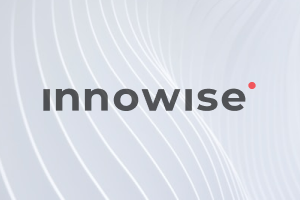Your message has been sent.
We’ll process your request and contact you back as soon as possible.
The form has been successfully submitted.
Please find further information in your mailbox.


Innowise partnered with the client to turn their vision of the decentralized on-chain bank into a full-featured, market-ready product. With advanced architecture and deep blockchain integration, it emerged as a user-centric platform bridging crypto and traditional finance.*
transactions processed globally through the platform
FinTech partnerships expanding the client’s ecosystem

Our client is a FinTech innovator focused on shaping the next-generation banking experience for crypto-savvy users. Using a blockchain-first infrastructure, the company merges the transparency of decentralized finance (DeFi) with the accessibility of traditional financial tools.
Detailed information about the client cannot be disclosed under the provisions of the NDA.
The client approached Innowise with a bold goal: build a decentralized banking platform that bridges fiat and crypto without compromising speed, control, or regulatory compliance. While the company had a solid DeFi foundation, it lacked the architectural capacity and development bandwidth to bring the on-chain bank to life as a scalable, production-ready platform.
From the outset, building the platform demanded enterprise-grade architecture with DeFi-native logic. This means building a scalable, secure system that integrates smart contracts, decentralized protocols, and traditional banking workflows.
Key blockers included:
The platform serves as a decentralized financial hub built atop that combines non-custodial blockchain technologies with the usability of traditional digital banking.
Users interact with the platform via web, Telegram, and mobile apps (Flutter-based) to manage fiat and crypto assets through a single interface. At the core of it lies a modular, microservices-based backend, where each service handles specific operations like user KYC, transaction processing, wallet management, loyalty rewards, and reconciliation.
Key architectural characteristics:
From the business side, a decentralized banking platform acts as a regulatory-light, feature-rich DeFi banking layer that gives users access to payments, credit, loyalty rewards, and staking. It provides these services with transparency, reduced fees, and global accessibility. The system was also designed to be jurisdiction-agnostic, ensuring easy adaptation to different regulatory environments and supporting global user onboarding with minimal KYC friction.
The project began with a comprehensive discovery phase. Innowise stepped in to define a scalable system architecture, working closely with the client’s CTO to align technical decisions with business objectives.
During this stage, we identified several gaps:
Innowise led the design of the end-to-end architecture, received sign-off from the CTO, and began implementation with a phased delivery plan to launch a stable MVP.
One of the cornerstone modules we rolled out was a secure wallet processing system, covering both custodial and non-custodial wallets. This allowed the platform to give users full control over their funds via smart contracts while also enabling flexible payment processing and account abstraction for real-world usability.
The wallet module supports:
We implemented a streamlined KYC processing module with minimal regulatory friction, tailored for multiple jurisdictions. The system supported fast user onboarding with flexible identity validation levels and future-proofed for global market expansion.
To support seamless movement between fiat and crypto, we integrated multiple third-party services for fiat onboarding (on-ramp) and crypto withdrawals (off-ramp). These integrations support real-time fiat conversion, wallet funding, and compliance tracking, bridging traditional banking with DeFi ecosystems.
The referral engine was among the most technically complex components of the platform. With deep inter-user dependencies and multi-level reward structures, this system required precision, transparency, and scalability.
We developed a fully custom module that:
Innowise implemented the backend logic for issuing virtual payment cards, fully linked to users’ non-custodial balances. We integrated processors into the system and configured them for Apple Pay and Google Pay support. Physical card issuance was also prepared and tied to the broader loyalty and KYC flows.
To ensure financial integrity, we implemented a robust reconciliation engine capable of:
This feature was essential for handling edge cases, resolving disputes, and maintaining compliance with financial standards in different jurisdictions.
To stabilize and scale the workflow, we introduced a Kanban-based methodology that brought much-needed predictability. Our team implemented release management workflows, coordinated cross-team efforts (design, product, development, and QA), and ensured that every sprint was aligned with the client’s strategic goals.
Key elements of our approach:
Beyond developing the product, Innowise established a scalable collaboration with the client. This included regular roadmap checkpoints, technical consultations with the client’s mathematicians and tokenomics experts, and backlog grooming sessions to adapt to the changing nature of a blockchain-native financial platform.
The decentralized banking platform introduces innovative features like token-based rewards, on-chain referral validation, and seamless wallet integration for a streamlined, Web3-native user experience. These capabilities set it apart as a true bridge between crypto and mainstream finance. This project proves that pioneering ideas can thrive in the ever-shifting world of crypto, setting new benchmarks for crypto-native banking.


The solution was successfully launched as a full rollout, becoming the flagship product in the client’s ecosystem. Innowise turned a fragmented concept into a production-ready, scalable banking platform. The team met tight deadlines and adapted quickly to shifting priorities.
Beyond the technical execution, Innowise played a pivotal role in helping the client:
Although usage metrics remain under NDA, the shift in the client’s internal roadmap demonstrates the platform’s business impact. The infrastructure now supports rapid iteration, partner expansion, and further integration across the client’s token economy.
Your message has been sent.
We’ll process your request and contact you back as soon as possible.

By signing up you agree to our Privacy Policy, including the use of cookies and transfer of your personal information.